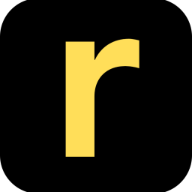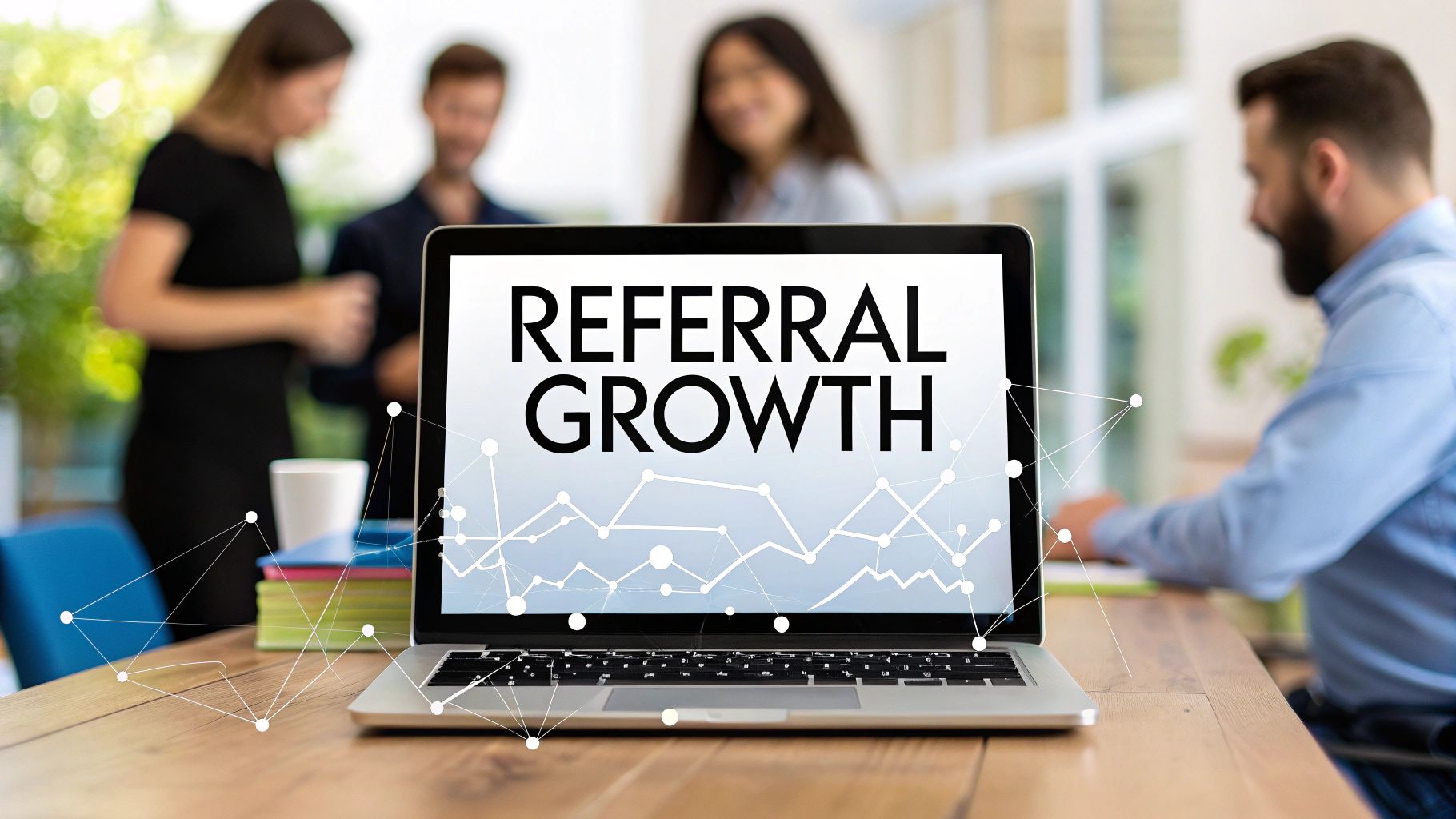A great referral program is built on a simple truth: customers who come from referrals are just plain better for your business. They're not just another number on your user dashboard; they're the foundation of more profitable, loyal, and sustainable growth. Getting this right from the start is what turns a simple feature into a genuine growth engine.
Why Referred Customers Are Your Most Valuable Asset
We all have a gut feeling that referrals are a good thing. But what’s the real, measurable impact on a SaaS company’s bottom line? It's time to dig into the actual numbers. A referred customer is a different breed, consistently bringing in higher lifetime value and sticking around longer. This makes the financial case for investing in a native referral program incredibly strong.
The secret ingredient is trust. When a friend or a colleague whose opinion you respect recommends a tool, that endorsement cuts through all the marketing noise. The new user shows up with built-in confidence and a solid idea of what your product does, setting the stage for a healthier customer relationship right from day one.
The Financial Impact of Trust
This built-in trust has a direct and powerful effect on your business metrics. Referred customers don't just sign up; they stay longer, spend more, and often become advocates themselves, kicking off a fantastic, self-sustaining growth loop. Their journey isn't about overcoming skepticism—it's about confirming an already positive impression.
This dynamic gives a serious boost to your most important SaaS metrics:
- Higher Lifetime Value (LTV): Referred users typically have a specific need in mind and are a better fit for your product's core features. This leads to deeper engagement and more upgrades down the line.
- Lower Customer Acquisition Cost (CAC): Instead of sinking cash into ads with questionable ROI, you're effectively paying your happiest customers to find more just like them. It’s a pure pay-for-performance model.
- Reduced Churn Rate: When someone signs up based on a peer's recommendation, they're far more likely to be the right fit for your product. This means higher satisfaction and much better retention.
The data paints a pretty clear picture of how a well-designed referral program can elevate your acquisition, conversion, and revenue.
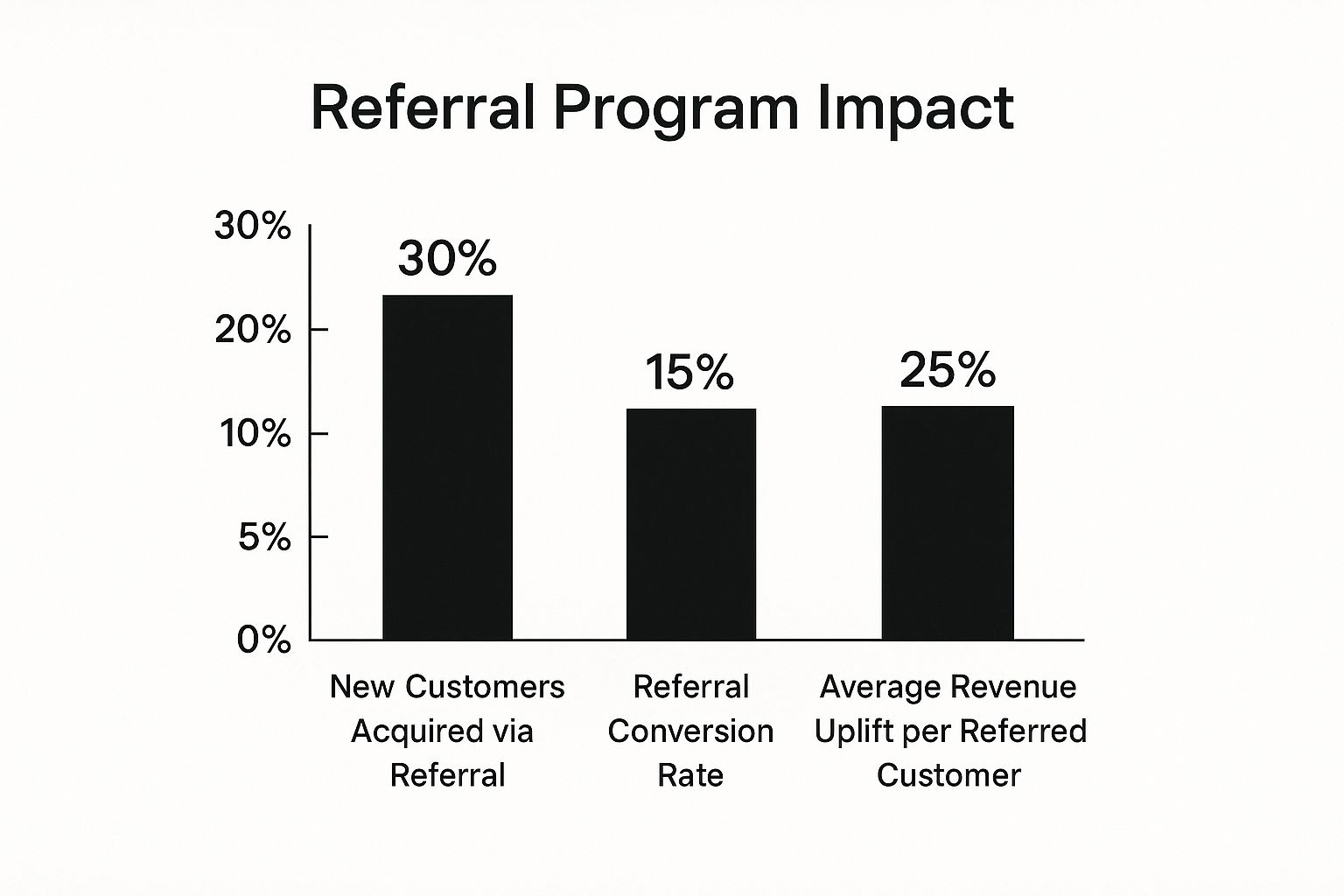
As you can see, referrals don't just bring in more customers—they bring in better ones who stick around.
The Real Value of Referred Customers vs Traditional Acquisition
Looking at the raw data makes the difference even clearer. Referred customers consistently outperform those from other channels across the board, proving their superior long-term value.
| Metric | Referred Customers | Customers from Other Channels |
|---|---|---|
| Lifetime Value (LTV) | 25% higher | Baseline |
| Churn Rate | 16% lower | Baseline |
| Acquisition Cost (CAC) | Significantly lower | Higher, often unpredictable |
| Conversion Rate | Higher due to pre-vetted trust | Standard industry averages |
This isn't just a minor improvement; it's a strategic advantage that compounds over time, building a more resilient and profitable user base.
The Metrics That Matter Most
The business value here goes way beyond just getting new sign-ups. It’s about building a foundation of trust and satisfaction that permeates your entire user base.
The numbers don't lie. SaaS companies with referral programs see 16% lower churn rates, and their referred customers deliver a 25% higher lifetime value. This makes perfect sense when you consider that a staggering 92% of consumers trust recommendations from people they know over any other form of advertising. A referral program basically weaponizes word-of-mouth, creating a growth engine that’s far more sustainable than paid ads. You can find more insights on these referral marketing stats over at Talkable.
The real magic of a referral program isn't just in acquiring new users; it's in acquiring the right users. These are customers who are already primed to love and succeed with your product, leading to a healthier user base and a much stronger bottom line.
When you empower your existing customers to become an extension of your marketing team, you build a competitive moat that's incredibly difficult for anyone else to copy. You're investing in relationships, not just leads. This shift in focus is what elevates a simple referral feature into a cornerstone of your growth strategy. Now, let’s get into how to actually build it.
Designing a Referral Program People Actually Use

A great SaaS referral program is never an afterthought. It's a carefully engineered experience that blends smart strategy with a real understanding of human psychology. The gap between a program that drives major growth and one that just sits there, collecting dust, is all in the design choices you make upfront.
It all boils down to figuring out what truly motivates your users to tell their friends and colleagues about you. Forget just slapping a generic "refer-a-friend" button in your app. The real goal here is to build an incentive structure that feels like a natural part of the value your product already provides.
Choosing Your Core Incentive Structure
The reward you offer is the fuel for your entire referral engine, so getting this right is non-negotiable. What works best will depend entirely on your product, its price point, and the kind of people who use it. There’s no magic bullet, but we can break down the most common and effective options for a referral program saas model.
- Account Credits: This is my go-to recommendation for most subscription-based SaaS. Offering a discount or credit on an upcoming bill is a classic win-win. Your customer gets a real financial benefit, which makes them stickier, and the cash stays inside your company's ecosystem.
- Cash Payouts: Let’s be honest, cash is king. It's often the most powerful motivator out there, especially for B2B tools with a higher price tag or for programs that are geared toward professional affiliates. It’s simple, universally valuable, and incredibly persuasive.
- Feature Unlocks or Upgrades: This is a clever way to tie the reward directly back to your product. Think about Dropbox's legendary program that offered users more storage space for referrals. This incentive works best when you have desirable premium features that free or lower-tier users are itching to get their hands on.
For example, a project management tool will likely see great results with account credits, as their users are businesses constantly looking to manage their bottom line. On the flip side, a high-ticket analytics platform might find a generous cash commission far more appealing to the professional marketers and consultants who would be referring new clients. We have a detailed guide on the fundamentals of building a referral program that explores these initial steps more deeply.
The Double-Sided vs. Single-Sided Debate
Once you know what the reward will be, you have to decide who gets it. This decision has a massive impact on the psychology of sharing.
A single-sided reward only benefits the person doing the referring. It’s simple, sure, but it can feel a bit transactional or even selfish. This can make users hesitate because they don't want to feel like they're "selling" their friends on something.
This is exactly why double-sided rewards are almost always more effective. In this model, both the referrer and their friend get a reward.
A double-sided incentive reframes the entire act of sharing. It shifts from a self-serving action to a mutually beneficial one. The referrer feels great about giving their friend a deal, and the new user feels welcomed with an exclusive offer, which dramatically boosts conversion rates.
Imagine someone using your social media scheduling tool. With a double-sided reward, they can say to a colleague, "Hey, if you sign up with my link, we both get a free month." That feels like a helpful tip, not a sales pitch. It turns your user into a genuine advocate, not just someone chasing a commission.
Crafting Messaging That Motivates
Your program's messaging is every bit as important as the reward itself. It has to be clear, compelling, and, most of all, human. Ditch the corporate jargon and focus on simple, benefit-driven language.
Instead of a boring headline like "Participate in Our Referral Initiative," go for something direct and exciting: "Give Friends 20% Off, Get $50." Boom. Both sides of the value proposition are instantly clear. All your in-app prompts and emails should follow this same principle—make it feel effortless and obviously rewarding.
This is especially powerful in the B2B SaaS world. While only around 30% of B2B SaaS companies have a formal referral program, the ones that do see fantastic results. Data shows that 86% of these companies saw revenue growth over a two-year period. A big reason why is that 73% of B2B executives would rather work with someone recommended by a person they already trust.
Ultimately, designing a program people will actually use comes down to understanding what makes people tick. By offering the right incentives, creating a win-win structure, and using clear, motivating language, you can turn a simple feature into an experience that empowers your best customers to become your most effective advocates.
Building Your Referral Program for a Seamless Experience
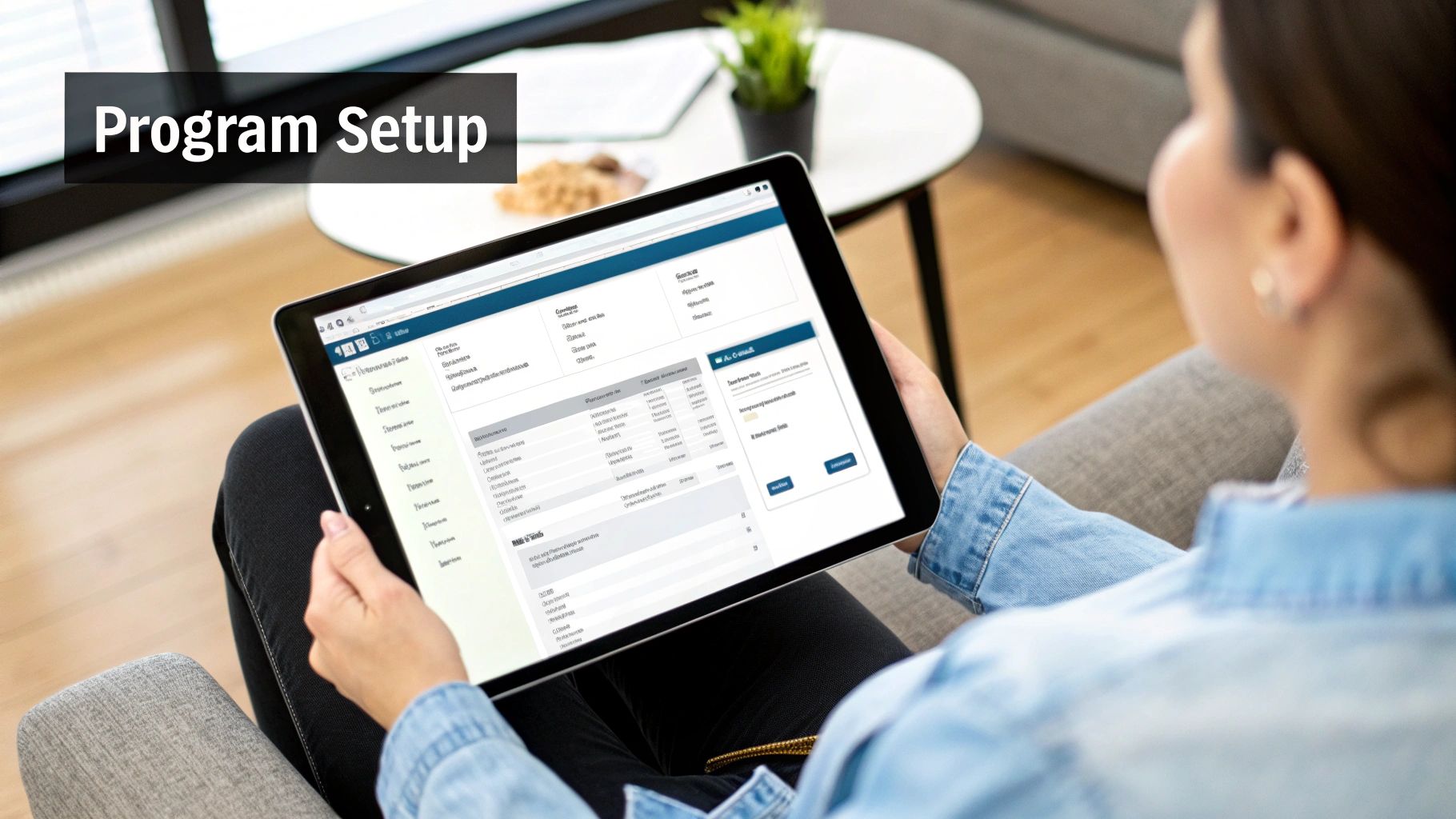
Now that you've designed a killer incentive structure, it's time to get your hands dirty and build the engine that will actually run your SaaS referral program. The aim here isn't just to bolt something on; it's to create an experience so slick and integrated that it feels like a natural part of your product. A smooth experience removes friction, builds trust, and gets more people to actually participate.
This all comes down to the core technical components working flawlessly behind the scenes. Whether you build these from the ground up or lean on a specialized platform, these pieces are the non-negotiable foundation of any program that works.
The Core Technical Blueprint
At its heart, a referral program is really just a system for tracking and rewarding. If you get the technical side right, every referral gets credited to the right person and every reward is delivered on time. This is what keeps your program's integrity intact.
You'll need to nail three key components:
- Unique Referral Codes & Links: Every single advocate needs their own unique identifier. This is usually a personal link or a short code they can easily share. This is the absolute cornerstone of your tracking system.
- A User-Facing Dashboard: Your advocates need a home base. This dashboard is where they can grab their link, see how many people have signed up (e.g., "Signed Up," "Became Customer"), and track the rewards they've earned. Transparency is everything for keeping people motivated.
- Reliable Attribution Logic: This is where the magic—and the complexity—happens. Your system must be able to accurately connect a new customer back to the person who referred them. This usually relies on cookies or tracking parameters baked into the referral link, and it needs to be smart enough to handle things like a user clicking a link but only signing up a week later.
A broken or confusing referral experience is worse than having no program at all. If a user refers a friend and doesn't get their promised reward due to a technical glitch, you haven't just lost a referral—you've damaged trust with one of your best customers.
Strategic Placement Inside Your Application
Where you put the referral program in your app directly impacts how many people see and use it. Just burying it in a settings menu is a surefire way to get zero engagement. You need to be smarter than that.
Think about your user's journey. When are they happiest? Where do they experience those "aha!" moments? Those are the golden opportunities to nudge them to share.
Here are a few high-impact places to consider:
- In the User Account/Profile Section: This is the most obvious and logical spot. A dedicated "Referrals" or "Get $50" tab makes the program easy to find whenever someone is poking around their account settings.
- After a Successful Action: Did your user just export a big report, hit a major milestone, or clear their inbox? That's the perfect time for a small, non-intrusive pop-up celebrating their win and suggesting they share the love.
- Within Onboarding Flows: Plant the seed early. Dropbox became legendary for this, integrating sharing right into their setup checklist. This single strategy fueled their 3,900% growth in just 15 months.
Imagine you run a project management tool. A great trigger would be right after a team marks a huge project as "complete." A simple message like, "Nice work! Know another team that could use a win like this? Give them a free month and get one, too" feels perfectly timed and relevant.
Ultimately, your goal is to weave the referral program into the very fabric of your product. It should feel like a natural extension of the value you already provide, making it dead simple for your happiest customers to become your most powerful growth channel.
Launching and Promoting Your Program for Maximum Impact
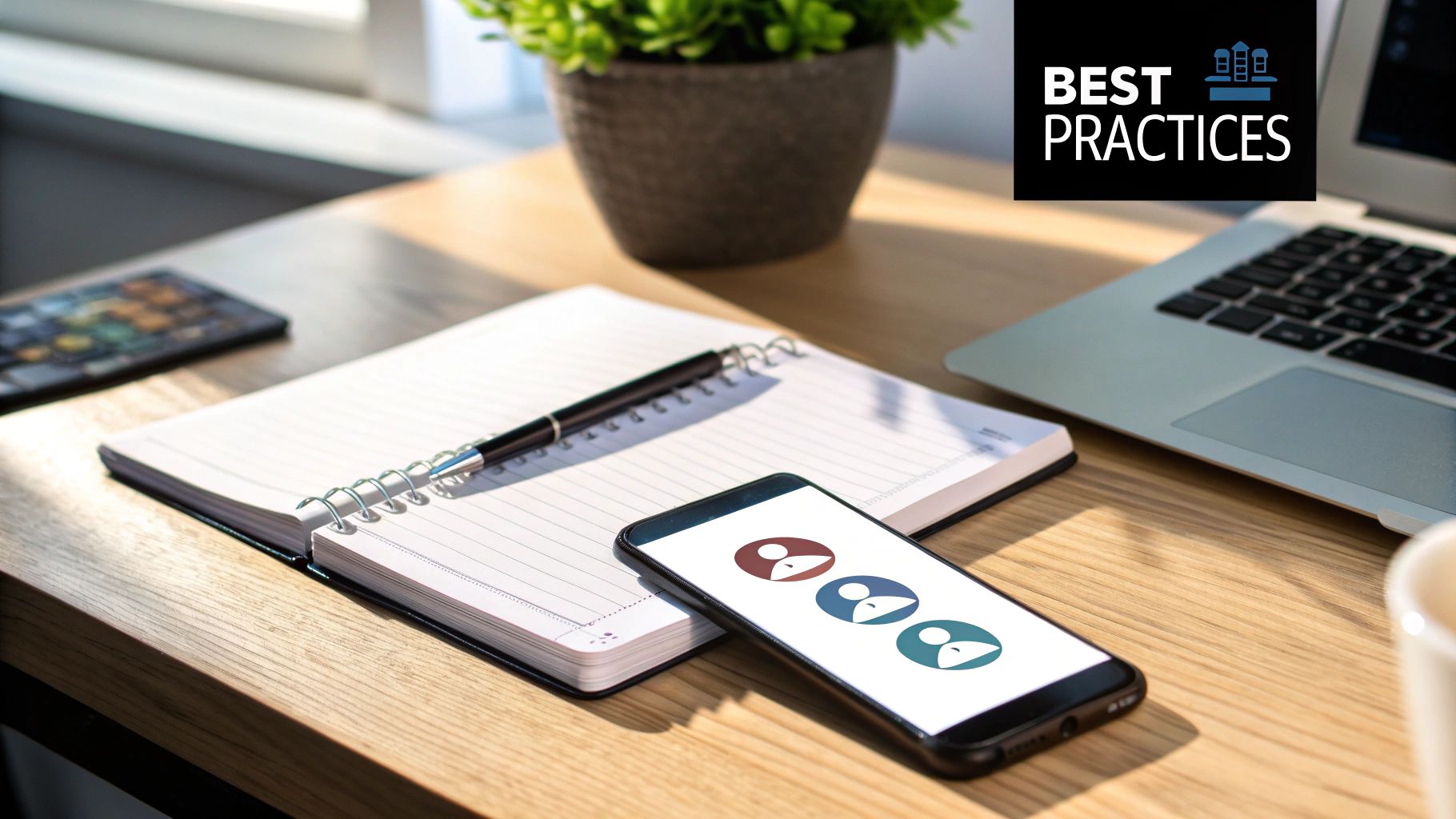
You’ve designed a fantastic reward and built a referral experience that’s smooth as butter. Now it’s time to make some noise. A brilliant referral program is useless if your customers don't even know it exists. The launch isn't just a single event; it's a coordinated push across multiple channels to make sure your program gets the attention it deserves right out of the gate.
A successful launch is much more than a single email blast. It’s about meeting your users where they already are, using a mix of high-visibility announcements and subtle, ongoing reminders. That initial buzz is absolutely critical for driving immediate sign-ups and gathering early data on what’s actually working.
Crafting Your Launch Announcement
Your existing users are your biggest fans, so the launch has to start with them. A dedicated email announcement is usually the most powerful way to kick things off. This isn't just another marketing message; think of it as an invitation for your best customers to become partners in your growth.
Keep the email punchy and scannable. Your goal is to get straight to the point: what's in it for them and their friends.
- Write a clear, benefit-driven subject line: Instead of "Our New Referral Program," go with something like, "Give a Friend 20% Off, Get $50." It’s direct and compelling.
- Explain the process in simple steps: Use visuals or a quick numbered list to show just how easy it is to share. Nobody wants to read a wall of text.
- Include an unmissable call-to-action (CTA): A big, bold button that says "Start Sharing Now" or "Get My Referral Link" should take them right to their personal dashboard.
At the same time, use in-app notifications to catch users while they're actively engaged with your product. A well-timed slide-in or a simple modal window announcing the new program can capture their attention without wrecking their workflow. The key is to be present but not annoying.
Expanding Your Promotional Reach
Once your program is live, you need to think beyond that initial announcement. Effective promotion is one of the best strategies to get more website traffic to your referral pages. Your blog and social media channels are perfect for building a bigger story around the program.
Write a blog post that shares the "why" behind it. Explain that you value their support so much you want to reward them for it. This humanizes the whole thing and makes it feel less transactional. Then, slice and dice that post for your social channels, creating custom graphics or short videos that highlight the rewards.
The goal of a multi-channel launch isn't just to inform users, but to create a sense of excitement and opportunity. When customers see the announcement in their inbox, in the app, and on social media, it signals that this is a core part of your company's value, not just a minor update.
This initial promotional blitz builds a strong foundation. But the real secret to a high-performing program is the ongoing, automated reminders that keep it top-of-mind long after the launch hype dies down.
Maintaining Momentum with Ongoing Promotion
A launch is just the beginning. To turn your referral program into a consistent growth engine, you need to weave promotion into the very fabric of your user experience. These subtle, ongoing nudges are what drive long-term participation.
Here are a few powerful, low-effort tactics I’ve seen work wonders:
- Email Signatures: Add a simple line with a link to the referral program in the email signatures of your entire team—especially customer support and success.
- Transactional Emails: Drop a small banner or a P.S. note about the program in receipts, invoices, and even password reset emails. These emails have crazy-high open rates.
- Post-Milestone Triggers: Automatically send a reminder when a user hits a key milestone in your app. For instance, after they export their 10th report or celebrate their one-year anniversary as a customer.
This approach keeps your program visible without causing banner blindness or fatigue. By tying reminders to positive moments in the customer journey, you’re asking for a referral when their satisfaction is at its absolute peak. That combination of a big initial launch and smart, continuous promotion is what separates a forgotten feature from a true, sustainable source of new customers.
Measuring and Optimizing Your Referral Program ROI
Getting your referral program live is a huge win, but it’s just the starting line. A truly great referral program isn't a "set it and forget it" feature; it's a living, breathing part of your growth strategy that needs constant attention. If you're not measuring, analyzing, and refining it, you're leaving a ton of potential growth on the table.
The real secret to maximizing your return on investment (ROI) is getting into the data. It’s all about looking past the surface-level numbers and digging into the metrics that show you what’s really happening. This is how you spot the weak links, double down on what’s working, and methodically build a referral engine that keeps getting better.
Identifying Your Core Referral Metrics
Before you can improve anything, you have to know what you’re measuring. Your dashboard should give you a clear, immediate view of the entire referral journey—from the moment a customer shares their link to the second their friend pays their first invoice. This lets you pinpoint exactly where people are getting stuck.
Here are the essential metrics you absolutely have to be tracking:
- Participation Rate: This is simply the percentage of your active users who have actually joined your program or shared their link at least once. It’s your top-of-funnel metric and tells you if your program is even visible and appealing enough to begin with.
- Share Rate: Of the people who signed up, what percentage are actively sending out invites? This number tells you a lot about how easy and compelling you've made the act of sharing.
- Referral Conversion Rate: This is the big one. It tracks the percentage of friends who clicked a referral link and actually became paying customers. A low rate here often means there's a problem with your landing page or the offer itself isn't hitting the mark.
These numbers tell a story. For example, a high participation rate but a low share rate could mean your users are interested in the idea but find the sharing process clunky or confusing. On the other hand, a high share rate but a low conversion rate suggests your advocates are doing their part, but the people they refer aren't being convinced to pull the trigger.
The goal isn't just to watch numbers go up and down; it's to diagnose problems. Each metric is a vital sign for your program's health, pointing you exactly where to focus your efforts for the biggest impact.
Benchmarking Your Performance
So you have your numbers. Great. But are they any good? This is where industry benchmarks come in handy. While every SaaS business is unique, knowing what "good" generally looks like helps you set realistic goals and spot where you’re lagging behind.
The data for SaaS referrals is incredibly motivating. We know that referred customers spend 25% more, are 27% more likely to stick around, and deliver a 37% higher retention rate. It’s not uncommon for top SaaS companies to see 15% to 30% of their new revenue coming straight from referrals. For more stats, you can check out some great insights on SaaS referral metrics on prefinery.com.
With that in mind, here are some healthy targets to shoot for:
| Metric | Industry Benchmark for SaaS |
|---|---|
| Program Participation Rate | 5% - 15% |
| Share Rate (per participant) | 25% - 35% |
| Referral Conversion Rate | 8% - 12% |
If your metrics are falling short, don’t worry. That just means you've found a clear opportunity for improvement.
A Framework for Continuous Optimization
Optimization is all about disciplined testing. Instead of throwing random changes at the wall to see what sticks, you need to use A/B testing to isolate variables and figure out what truly moves the needle. This is where you turn those data insights into real-world improvements.
Think of yourself as a scientist running experiments. You form a hypothesis, run a controlled test, analyze the results, and do it all over again. If you want to explore the bigger picture, our guide on powerful referral marketing strategies is a great place to start.
Here are a few high-impact areas perfect for your first experiments:
- Test Your Rewards: Is a $50 account credit a better motivator than a free month of your service? Does a double-sided reward (like "$25 for you, $25 for your friend") bring in more new customers than a single-sided one? Your incentive is the fuel for your program, so small tweaks here can lead to massive gains.
- Optimize Your Headlines: The headline on your referral page is your sales pitch. Try testing a benefit-focused headline like "Give a Free Month, Get a Free Month" against a more direct one like "Refer Friends & Earn Cash."
- Refine Your Call-to-Action (CTA): You'd be surprised how much the text on a button can matter. Does "Start Sharing" outperform "Get My Link"? Test different button colors, placements, and phrasing to see what gets the most clicks.
By consistently measuring your core metrics and running targeted tests, you can turn a static referral page into a dynamic growth machine that delivers a strong, predictable ROI.
Common Questions About SaaS Referral Programs
Even the best-laid plans run into questions. When you're building a referral program, a few common hurdles and practical concerns always seem to pop up. Let's tackle them head-on so your program can launch smoothly and start delivering real results.
One of the first decisions you'll face is whether to build a system from scratch or use dedicated software. A DIY approach gives you complete control, but it's a massive drain on engineering time and resources. For most SaaS companies, specialized software is the smarter play—it handles the messy work of tracking, attribution, and reward payouts right out of the box.
Preventing Fraud and Abuse
What stops people from gaming the system with fake sign-ups? This is a huge concern, and rightly so. You absolutely need a solid fraud prevention strategy. The first line of defense is setting clear terms. Define exactly what counts as a successful referral. Does the new user need to become a paying customer? Do they need to stay active for a certain period? Spell it out.
From there, you'll want some technical safeguards in place:
- IP Address Monitoring: Keep an eye out for multiple sign-ups coming from the same IP address. It’s a classic red flag.
- Delayed Payouts: Don't pay out rewards instantly. Hold them in a pending state for 30 days or so to make sure the new user sticks around and doesn't immediately churn.
- Manual Review: If you're offering high-value rewards, it's worth taking a few minutes to manually review the referral before approving the payout. A little due diligence goes a long way.
These layers of protection keep your program honest without making things difficult for your legitimate advocates. We dive deeper into building secure customer referral programs in our dedicated guide if you want to explore more strategies.
Identifying Your Best Advocates
So, how do you find the customers who are most likely to send new business your way? Your own data holds the answer. Your best potential advocates are almost always your happiest, most engaged users. A great way to pinpoint them is by using tools like these NPS survey templates to measure customer loyalty.
Anyone who gives you a Net Promoter Score (NPS) of 9 or 10 is what we call a "Promoter." These are the folks who already love what you do. Sending them a personalized invitation to join your referral program is often all it takes to get the ball rolling.
By thinking through these practical issues upfront, you can build a referral program that's not just effective, but also secure and scalable. You'll be turning your happiest customers into your most powerful growth channel.
Ready to launch a fully native referral program without the headaches? With Refgrow, you can embed a customizable affiliate dashboard directly into your SaaS in minutes. Start growing with Refgrow today!
